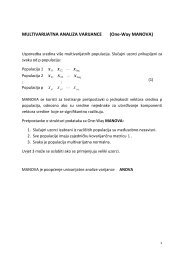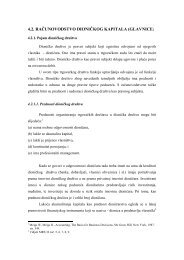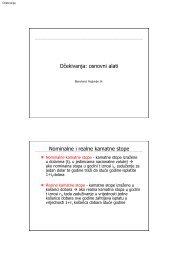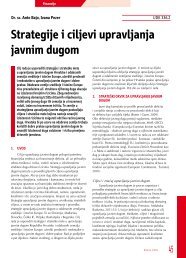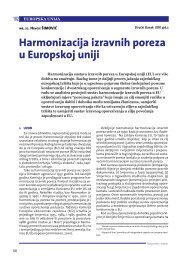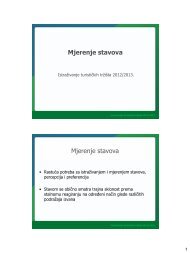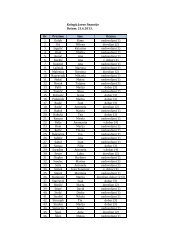Levi Strauss & Co.: They Go On campaign Encyclopedia of Major ...
Levi Strauss & Co.: They Go On campaign Encyclopedia of Major ...
Levi Strauss & Co.: They Go On campaign Encyclopedia of Major ...
You also want an ePaper? Increase the reach of your titles
YUMPU automatically turns print PDFs into web optimized ePapers that Google loves.
Unfortunately for <strong>Levi</strong>'s, its market share with the consumer group <strong>of</strong> 15- to 19-year-olds dropped from 33 percent in 1993 to 26 percent in<br />
1997. <strong>Levi</strong>'s learned that this statistic was not a fluke when a yearlong research project indicated that the "echo boomers," children <strong>of</strong> baby<br />
boomers, considered <strong>Levi</strong>'s passé. Steve <strong>Go</strong>ldstein, vice president <strong>of</strong> marketing and research for <strong>Levi</strong>'s USA, told BusinessWeek, "Kids say<br />
they love the <strong>Levi</strong>'s brand. But if you ask them whether it's 'with it,' they'll say no." Sixteen-year-old Irma Cruz stated in the <strong>Co</strong>lumbian,<br />
"<strong>Levi</strong>'s are too straight, too plain … None <strong>of</strong> my friends wear them." <strong>Levi</strong>'s needed to present a fashionable and modern <strong>campaign</strong> that<br />
would win over these consumers.<br />
COMPETITION<br />
As more players entered the lucrative denim market in the 1990s, <strong>Levi</strong>'s faced growing competition. According to the 1998 Market Share<br />
Reporter, VF <strong>Co</strong>rporation, the maker <strong>of</strong> Lee and Wrangler jeans, held 30.1 percent <strong>of</strong> the U.S. market, compared to <strong>Levi</strong>'s at 16 percent.<br />
Designer labels also infiltrated the market, with Guess, Tommy Hilfiger, Calvin Klein's CK, Nautica, Diesel, and Ralph Lauren's Polo among<br />
the high-end labels fighting for market share. Gap, along with its Old Navy clothing line, also posed a threat. Private-label jeans, such as<br />
J.C. Penney's Arizona line and Sears, Roebuck's Canyon River Blues series, also entered the market and gobbled up valuable jeans<br />
dollars. According to the Tactical Retail Monitor, as reported in the Los Angeles Times, private-label jeans experienced a rise in market<br />
share from 3.2 percent in 1990 to 19.1 percent in 1997.<br />
Alan Millstein, a New York retail consultant and editor <strong>of</strong> Fashion Network Report, told Advertising Age, "<strong>Levi</strong>'s is in a pincers from the<br />
private-label and specialty brands in department stores and the designer brands." According to the Los Angeles Times, Tony Cherbak, a<br />
Deloitte & Touche retail-industry analyst, agreed with Millstein and stated, "For a long time, they were the only game in town … <strong>They</strong> were<br />
able to demand prices and dictate display. But as other brands ate into their market, retailers could turn elsewhere or make their own<br />
private label brands."<br />
MARKETING STRATEGY<br />
To boost its popularity with the younger market and to lure customers, <strong>Levi</strong>'s chose to launch the $90 million image-building <strong>campaign</strong><br />
based on the strength <strong>of</strong> its brand. <strong>Levi</strong>'s Fanoe was quoted in the San Francisco Chronicle as saying, "The ads will be built around what the<br />
<strong>Levi</strong>'s brand stands for: originality, independence and <strong>Levi</strong>'s as an American icon." The biggest and most expensive <strong>campaign</strong> instigated by<br />
<strong>Levi</strong>'s, "<strong>They</strong> <strong>Go</strong> <strong>On</strong>" included six television spots, five <strong>of</strong> which lasted 60 seconds and one 90 seconds. It debuted in August 1997 on<br />
prime-time network television and during telecasts <strong>of</strong> National Football League games on Fox as well as on MTV. The spots were also shown<br />
in movie theaters across the nation. The print and outdoor portions <strong>of</strong> the <strong>campaign</strong> began in October with print ads in magazines such as<br />
Rolling Stone and Sports Illustrated. <strong>Levi</strong>'s home page on the World Wide Web provided additional ad information, and the <strong>campaign</strong><br />
included bilingual spots in Spanish and English for viewers in the Los Angeles and Houston areas. <strong>Levi</strong>'s expected 94 percent <strong>of</strong> its target<br />
consumers to see the <strong>campaign</strong> an average <strong>of</strong> 15 times each.<br />
CELEBRITY CAMEOS<br />
Several <strong>of</strong> the spots in the <strong>Levi</strong>'s "<strong>They</strong> <strong>Go</strong> <strong>On</strong>" <strong>campaign</strong> featured appearances by celebrities. Author Quentin Crisp<br />
appeared as a patron in a nightclub, and musician Lenny Kravitz was the rock star stuck at a gas station's pay phone. The<br />
bag boy in "Bag Boy Fantasy" was played by Brian Vaughan, the actor who had portrayed the young Brad Pitt character in<br />
the film Seven Years in Tibet, and the riled agent <strong>of</strong> the rock star was played by Bodhi Elfman, son <strong>of</strong> Danny Elfman,<br />
musician and member <strong>of</strong> the rock band Oingo Boingo.<br />
The six television spots shared a loosely interwoven narrative. <strong>Co</strong>mmon elements linked the spots, but the elements were <strong>of</strong>ten random,<br />
and viewers had to pay close attention to notice the connections. As Amy Rosenthal, the senior marketing specialist at <strong>Levi</strong>'s USA,<br />
explained to the Dallas Morning News, "We call it dream logic … There's no beginning, middle or end, just a series <strong>of</strong> little vignettes. Nothing<br />
much happens, but they are connected in interesting ways by interesting things." The strategy was similar to those adopted by competitors<br />
Lee and Guess, both <strong>of</strong> which produced television spots that were like minifilms that told stories, albeit nebulous ones, designed to push an<br />
image rather than a product. It was believed that this s<strong>of</strong>t-sell approach would appeal to teenagers who had become jaded about pushy<br />
advertising. In the Dallas Morning News James Twitchell, author <strong>of</strong> Adcult USA, commented on the <strong>Levi</strong>'s <strong>campaign</strong> by remarking, "It's the<br />
ultimate super-s<strong>of</strong>t sell, so s<strong>of</strong>t there's no sell at all … Advertising has become so omnipresent, the only way to cut through it is with<br />
something that doesn't look like an advertisement."<br />
<strong>Levi</strong>'s hoped that the target consumer would be engaged by the spots and encouraged to view all <strong>of</strong> them. Unlike other episodic <strong>campaign</strong>s<br />
that televised one spot at a time, <strong>Levi</strong>'s chose to show the commercials in groups <strong>of</strong> two or three in an attempt to draw in the viewer and to<br />
signify that the spots were indeed related. Andy Berkenfield, Foote <strong>Co</strong>ne & Belding account manager and vice president, told the Dallas<br />
Morning News, "You do worry with this sort <strong>of</strong> episodic storytelling that it will be confusing, so you try to make it pretty obvious, especially<br />
early on."<br />
The first spot, the 90-second "Impala Man," featured a man wearing a cowboy hat who drove a Chevrolet Impala filled with stuffed animals<br />
to a diner. In the diner he talked to D.J. Marcus, a New York-bound disc jockey, and gave away a stuffed dinosaur. The following spot, "Car<br />
Chase," starred a Kojak-obsessed cab driver employed by a plainclothes policeman to chase a thief making a getaway on a moped. The<br />
cab driver engaged in a high-speed chase, with the nervous <strong>of</strong>ficer in the backseat. In the third spot, "Ice Cream Man," the disc jockey<br />
from the first spot returned as a disc jockey in a trendy nightclub, an ice cream man would not hand over ice cream to young children<br />
unless they correctly answered difficult trivia questions, and a rock musician spoke on a pay phone at a gas station. "Bag Boy Fantasy"<br />
showed the agent <strong>of</strong> the rock star on a cellular phone in a grocery store while the bag boy daydreamed <strong>of</strong> being a rock star. "Test Drive,"<br />
the fifth installment, included a girl who took a car on a test drive, with the dealer in the backseat making sales claims. She stopped to pick<br />
up her boyfriend and then drove to a c<strong>of</strong>fee shop. The final spot, "Car Wash," featured a goggles-clad man who drove an AMC Gremlin<br />
through a car wash with the windows rolled down, thus washing the inside and outside <strong>of</strong> the car. As he exited the car wash, the Impala



